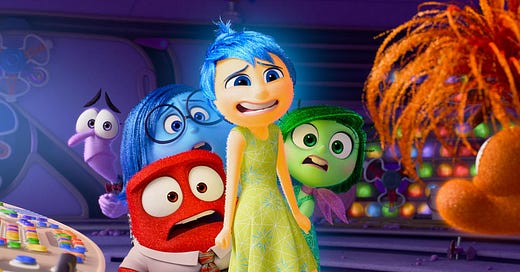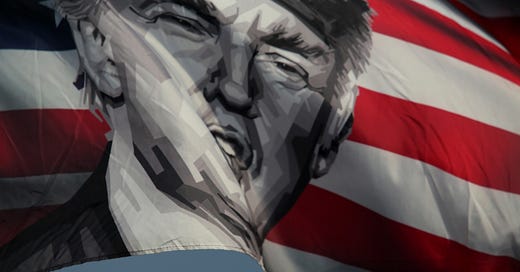
THE JOKE ABOUT INSIDE OUT WAS THAT after giving toys feelings in Toy Story and giving cars feelings in Cars Pixar had decided to give feelings feelings in Inside Out. It’s funny because it’s true: the literalness of character names like Joy (Amy Poehler) and Anger (Lewis Black) gave the whole thing a fairly obvious text-for-subtext vibe. Still, it pulled the Pixar trick of hitting you right in the feels throughout, most particularly when Riley’s childhood imaginary friend, Bing Bong (Richard Kind), consigned himself to deletion to save Joy from the shadowy ball pit of lost memories, or some such.
I don’t remember the precise name because it’s been a few years and I’ve lost a few memories of my own. But in the meantime, I’ve gained a couple of kids, another decade of life experiences, and a growing . . . let’s say distaste for therapy culture. All of which is to say that Inside Out 2 hits a little differently this time around.
The setup is pretty simple. Our favorite emotions (Joy, Anger, Fear, Sadness, and Disgust) have capably guided Riley and managed her memories into creating a solid set of core beliefs. Riley hits puberty the night before heading off for hockey camp with her two best friends, and the influx of new feelings (Anxiety, Embarrassment, Envy, and Ennui) collide with the friends’ revelation that they won’t be attending the same high school as Riley. Now anxious over what the future holds and how she’ll be able to make friends before attending high school, Riley has to work her way into the good graces of the girls on the high school hockey team or die an outcast ethnomusicologist, unloved by anyone.
It’s hard to tell if it’s me or the movie, but the text-for-subtext stuff is more grating in the sequel. At one point, the puberty-created Anxiety (Maya Hawke) says “You just aren’t what she needs anymore, Joy,” to Joy, resulting in Joy and the rest of the emotions from the first film being literally bottled up (get it?), where they will be imprisoned in a vault filled with lost memories. They escape, of course, and on the way back to Riley’s brain’s command center, they’ll encounter light-bulb-dispensing brain storms (please tell me you get it) while rafting along the stream of consciousness (like the thing we have, but in the form of an actual stream) and attempting to cross the sar-chasm (it sounds like, yeah, you got it, great).
Again, subtext is not really a “thing” in this movie.
And that would be fine—the first wasn’t particularly subtle in that regard—if the emotional beats all landed like they were supposed to or if the creative beats hit their marks. Occasionally, Inside Out 2 is quite funny; there’s a great moment when Anxiety has “turned Riley’s imagination against her,” and the image is hilariously literal, just a bunch of imagineers coming up with novel ways for Riley’s life to be miserable, for her to fail. And there are some cute gags, like a Blue’s Clues–style repressed memory, in which a fanny pack called “Pouchie” dispenses useful goodies to onlookers. The best of the new emotions is Ennui—the most useful mode for any teenager—and the character design is wonderfully French (Adèle Exarchopoulos does an excellent job with the voice and executive producer Pete Docter’s team did a great job of putting together her rubbery look), but what really makes the character work is the one thing that snaps her out of her malaise. I won’t spoil it here, but it was the perfect mix of silly and realistic and representative of the motivations of a teenager.
Unfortunately, the emotional beats just didn’t land. Perhaps it’s because I’m not a naturally anxious person and Anxiety is the most prominent emotion on display. But I keep thinking back to Bing Bong from the first film: that character’s joyful exuberance, its understanding of its purpose, and its noble sacrifice to help its child grow were universal and deeply, profoundly moving in a way that got under the skin and into the soul.
If you like puns and you don’t mind therapy-talk, you’ll likely find much to love with Inside Out 2. Despite not loving it, I didn’t hate it; it’s occasionally cute. But it does feel empty in a way the first simply wasn’t.
















